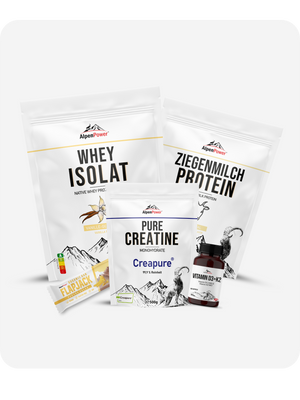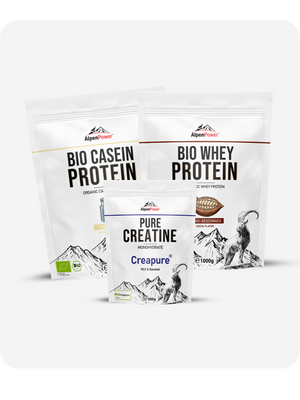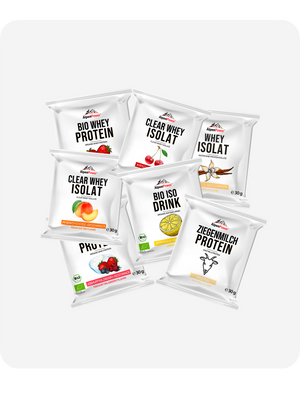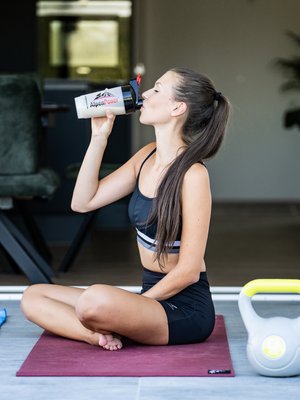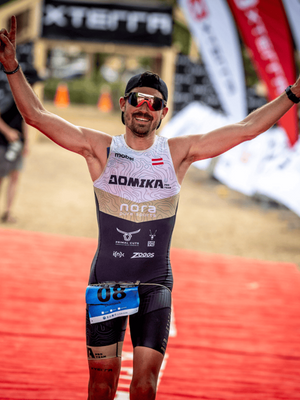Learn how to adapt carbohydrates, protein & fat to exercise, recovery and tapering phases - including AlpenPower product tips.
Periodized nutrition is the key to taking your training to the next level. Just as your training plan is divided into phases, you should also adapt your macronutrient distribution- i.e. the ratio of carbohydrates, protein and fat - to stress phases, recovery phases and tapering phases. This concept, known as "fuel for the work required", ensures that you can deliver maximum performance on hard days, regenerate optimally on calm days and be in top shape at the starting line during the competition.

Targeted use of carbohydrates
Carbohydrates are the most important source of energy for intensive exercise. During the exertion phase, the requirement increases to 6-10 g per kilogram of body weight, and even to 12 g/kg if the training volume is very high. Before and during hard sessions, you should rely on fast energy sources such as AlpenPower Organic Energy Gel 40 (40 g CHO with an optimum 2:1 glucose:fructose ratio) or organic maltodextrin DE10 in your sports drink. After the session, 1-1.2 g/kg of carbohydrates per hour will help to quickly replenish your glycogen stores. During the recovery phase, reduce the carbohydrate content to 3-5 g/kg. This avoids unnecessary energy storage without jeopardizing recovery. High-quality protein sources such as AlpenPower Whey Isolate or Clear Whey ensure that your muscles are optimally supplied even on low-carb days.

Keep protein constantly high
Regardless of the training phase, you should consume 1.6-2.2 g of protein per kilogram of body weight per day, spread over several meals. This promotes muscle building and repair and supports immune function. Especially in combination with quickly digestible protein sources such as AlpenPower BIO Whey Protein or Whey Isolate, muscle protein synthesis is optimally stimulated.
Do not neglect fats
Fats provide energy, support hormone production and help with the absorption of fat-soluble vitamins. Your fat content should be between 20 and 35% of your total energy - even in low-carb phases. Look for high-quality sources such as nuts, seeds and vegetable oils.

Tapering - the phase before the competition
The right carbohydrate load is important in the last week before a competition. 24-48 hours before the start, you should consume 8-12 g/kg of carbohydrates to fill your glycogen stores to the maximum. This is particularly easy with Organic Maltodextrin DE10 in drinks or Organic Energy Gel 40 for a quick energy boost. At the same time, reduce fiber and fat to relieve the gastrointestinal tract.
Strategic advantages of periodized nutrition
- Load phase: High CHO availability for maximum performance quality.
- Recovery phase: Moderate CHO, constant protein level, slightly increased fat percentage.
- Tapering: CHO loading for full energy stores and competition peak.
This system not only improves your performance, but also minimizes the risk of RED-S (Relative Energy Deficiency in Sport), a nutritional deficiency that can cause hormonal and health problems.
AlpenPower - the right products for every phase
- High-CHO load days: Energy Gel 40, Bio Maltodextrin, Cluster Dextrine.
- Low-carb recovery days: Whey Isolate, Clear Whey, Goat Whey Protein.
- Tapering & Competition: Bio Maltodextrin, Cluster Dextrin, Energy Gel 40
With targeted , periodized nutrition and the right AlpenPower products, you can get the most out of your training. Adapt your macronutrients to the training phase, test your strategy in training - and start your next competition with full energy stores, a clear strategy and maximum performance.
Author: Laura Bahmann
Sources:
- Burke, L. M., & Hawley, J. A. (2018). Swifter, higher, stronger: What's on the menu? Science, 362(6416), 781-787. https://doi.org/10.1126/science.aau2093
- Impey, S. G., et al. (2018). Fuel for the work required: A theoretical framework for carbohydrate periodization and the glycogen threshold hypothesis. Sports Medicine, 48(5), 1031-1048. https://doi.org/10.1007/s40279-018-0870-2
- Thomas, D. T., et al. (2016). Position of the Academy of Nutrition and Dietetics, Dietitians of Canada, and the American College of Sports Medicine: Nutrition and athletic performance. Journal of the Academy of Nutrition and Dietetics, 116(3), 501-528. https://doi.org/10.1016/j.jand.2015.12.006
- Jeukendrup, A. E. (2017). Periodized nutrition for athletes. Sports Medicine, 47(Suppl 1), 51-63. https://doi.org/10.1007/s40279-017-0694-2
- Burke, L. M., et al. (2011). Carbohydrates for training and competition. Journal of Sports Sciences, 29(sup1), S17-S27. https://doi.org/10.1080/02640414.2011.585473
